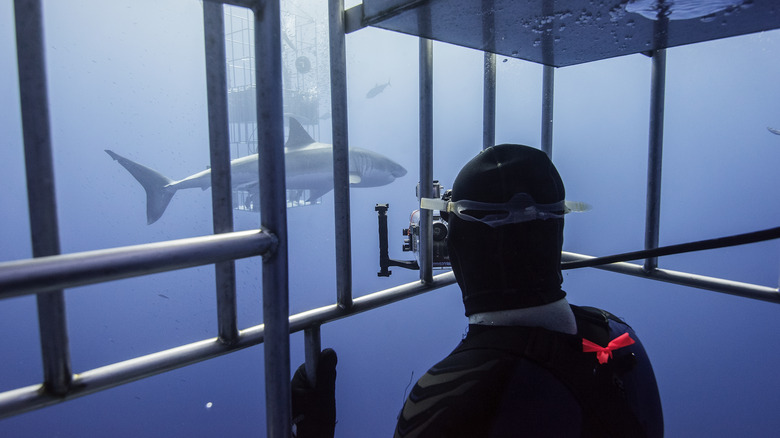Where To Travel If You Want To See A Great White Shark In Nature
The past decade has seen an upwards trend in wildlife getaways. Even more recently, last chance tourism, where people yearn to see disappearing locations or species, has become increasingly popular. One segment of travel that overlaps both of those trends (and has become both increasingly popular and controversial) is white shark tourism.
Great white sharks are among the largest and most dangerous types of sharks in the world. Growing up to 21 feet long and reaching weights of as much as 4,500 pounds, these sharks are an awe-inspiring sight. In fact, they are the largest predatory fish in the world. They are found in a wide range of waters around the world. However, they are also listed as vulnerable by the International Union for Conservation of Nature and Natural Resources. Furthermore, the population of great white sharks is steadily declining. The combination of their rare physical immenseness along with their increasing scarcity has led to both wildlife and last chance tourists seeking out opportunities to see them.
Shark tourism has also been met with resistance from some conservationists, who believe methods used to attract and view sharks are detrimental to their well-being. There have also been concerns raised about the safety of people participating in activities like shark dives. As a result, some popular white shark viewing areas, such as the Guadalupe Islands Biosphere Preserve, have been closed to tourism. However, according to Shark Stewards and others, shark dives, as well as boat tours, can be conducted in a responsible manner which is safe for both sharks and people. Here's where to travel if you want to see a great white shark in nature.
Best places to see white sharks in North America
While white sharks are migratory and swim throughout all of the world's oceans, there are a number of spots in North America that provide an excellent opportunity to encounter them. The Farallon Islands, which are situated just under 30 miles off the California coast from the city of San Francisco, have long been noted as drawing good numbers of incredibly large white sharks as they migrate through the Pacific Ocean. The waters surrounding the Farallon Islands are designated as a National Marine Sanctuary. Both boat and dive tours are available from various operators. The white sharks are in the highest concentration from mid-summer through early winter. However, September through November is considered the peak time.
On the opposite coast, a recent rise in the number of great white sharks spending time off the New England coast has resulted in an entire fleet of white shark tour boats coming into operation. Most of these tour boat operators are based out of Cape Cod, Massachusetts. To increase the odds of finding sharks during these tours, many of the boats work in conjunction with spotter planes to find sharks without resorting to baiting them. The best time to view great whites in Cape Cod is mid-summer through fall, between July and October.
Further to the south, Mexico's Baja Peninsula has long been a popular spot for viewing a variety of marine creatures, including whales and great white sharks. Although shark dives in the Guadalupe Islands Biosphere Preserve, an area once considered to be the best shark dive location in the world, are closed, there are numerous areas nearby that offer both boat and dive tours for viewing great whites.
Best places to see white sharks around the world
South Africa has become famous worldwide not only for having a large population of great white sharks, but also for some of the unique behaviors the sharks in these waters exhibit. This is one of the few areas in the world where great white sharks have been witnessed breaching or breaking through the surface of the water to feed on their prey. To witness this behavior, one needs to be on a boat, not under the water, so boat tours are quite popular in places such as False Bay. This behavior is most often seen during the winter seal migration, which in the Southern Hemisphere takes place around May. Be advised the seas this time of year can be rough, so if you are prone to seasickness you may want to come prepared with MQ Motion Sickness Patches or Sea-Band Anti-Nausea Wristbands.
Australia is another well-known white shark area. The waters all around Australia hold a population of white sharks. However, New South Wales has become famous as a great white shark nursery. This area is home to a large population of juvenile white sharks that are frequently seen feeding. Those hoping to cage dive with mature white sharks while in Australia should look to book a tour around the Neptune Islands. This is the only area in Australia where cage diving for great whites is allowed. The waters around the island, which are a marine conservation park, afford an outstanding opportunity to view mature migrating great whites from May through October, which constitutes winter and spring in the Southern Hemisphere.


